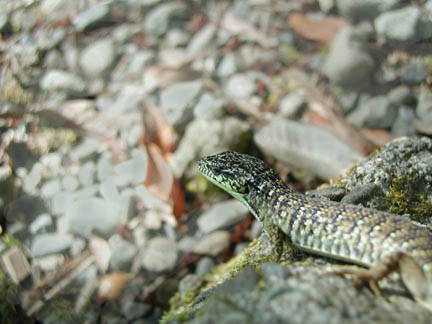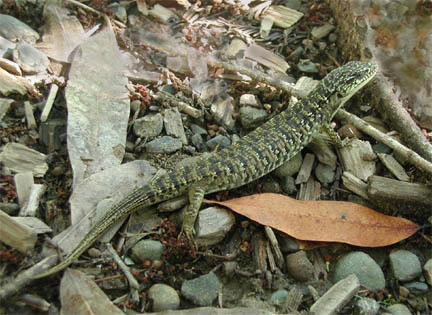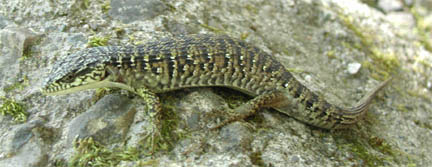



 |
|
 |
|
Alligator Lizard
Elgaria multicarinata
(formerly Gerrhonotus multicarinata)
![]()



This alligator lizard was photographed in camp in 2006. He was very good to pose for so many photographs before he ran off into the leaves to hide and forage for insects.
The alligator lizard is the most common reptile in the redwood forest and the most common one at Caz. There are 67 species of alligator lizards ranging throughout the world. The ones common to North America, Elgaria and Gerrhonotus, includes 8 species ranging from southern Canada down through Central America. We have the Southern Alligator Lizard, which is found from Washington to Baja. There are three subspecies. It is a beautiful lizard, and the largest ones can be 20 inches long (if their original tail has not broken off: the one I photographed at Caz in April, 2004, has regrown his tail.) Alligator lizards are fairly aggressive and will threaten you with an open mouth, and they may bite anytime you pick them up, so be careful. Here I am not saying "be careful" so you don't get hurt! Be careful so that you don't hurt the lizard! Its teeth or jaws could be hurt if you are too rough. Remember, they should be treated with kindness even if they do bite you. After all, no one made you attempt to pick one up. And be careful of their tails, as they can break off if you try to catch one by the tail. (Blue-bellies have more fragile tails, and skinks have the most fragile: I have seen them knock their own tails off!)
Most characteristic is its prominent longitudinal fold of small, granular scales along each side. These contrast with the relatively large scales on the back and belly and allow for the expansion of the sides when the animal is breathing, feeding, or carrying young. It is wary in the open and usually found under cover of bark, logs, or stones.
Alligator lizards are most likely to be found in underbrush or dense leaf litter, where they prowl for insects, spiders and other leaf litter arthropods. Don't be afraid if you see one in your tent: they are the local "bug" exterminator! If you give it half a chance, it will just run away.
They shed in one piece, like a snake. If you look closely, you will see that the hands and feet are turned inside-out, like a glove.
![]()
Here is some more information of a scientific nature.
| SCIENTIFIC CLASSIFICATION Alligator Lizard CLASS: Reptilia ORDER: Squamata SUBORDER: Sauria FAMILY: Anguidae SUBFAMILY: Gerrhonotinae GENUS & SPECIES: Elgaria multicarinatus |
The Anguids (pronounced an-gyou-ids) are collectively known as the lateral-fold lizards. Anguilla is Latin for eel; gerrhon is Greek for wickerwork and nota is Latin for mark (a reference to the scale pattern) and carina is Latin for keel or ridge so multicarinatus means many ridges = the eel-like lizard with the many-ridged wickerwork pattern.
RANGE: Throughout California, even to fairly high elevations (9000 feet). Prefers areas of more dense vegetation with down logs and brush piles for daytime refuge. It likes human habitation because of woodpiles and debris.
PHYSICAL DESCRIPTION: Coloration: Grey-tan background with brick-red and dark brown squarish marks forming bands. The head is more brown, with straw-colored eyes. The belly (and the skin in the folds) are cream color, with occasional flecks of black.
The cylindrical trunk with relatively short, skinny legs, long tail and general appearance is definitely reminiscent of an alligator. The scales are regular, squarish and in straight rather than diagonal rows. The scales are keeled with dermal ossicles (bones in the skin), so the skin is rather stiff and there is a lateral fold. The unbroken tail is usually longer than the body. Male head broader than female. Oviparous, laying 1 to 3 clutches of 5 to 20 eggs in May through July.
DIET: Small insects (like crickets) and worms or insect larvae. Occasionally, the larger lizards will take small vertebrates like young mice.
BEHAVIOR: When pursuing prey, the lizard stalks slowly, moving limbs very carefully. When within range, the lizard raises up on the forelimbs and strikes down. The rapid thrust of open mouth, coupled with the powerful jaw grip is quite effective. The large gape allows the lizard to swallow large prey. The tongue often licks the lips after swallowing.
ADAPTATION: The lateral folds are elastic, with no stiff scales and no dermal ossicles in this location. They aid in breathing and flexibility (as well as room for egg production).
The eel-like shape is ideal for sliding in and out of crevices and tunnels. A large lizard can easily travel down a mouse burrow and can, ferret fashion, turn around. They often slide along through leaf litter using only the hind limbs to drive the sliding.
The tongue is slightly forked and there is a Jacobson's Organ. The ground and surrounding items are often "tasted" by the flicking tongue but, as with snakes, the real action is smelling.
OTHER REFERENCES
Here is a neat website with information about all of California's snakes and lizards: California Reptiles and Amphibians.